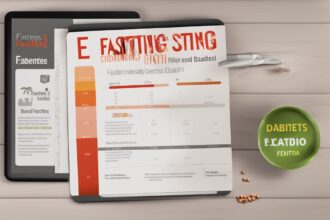Diabetes is a chronic condition affecting millions worldwide, and managing it often feels like walking a tightrope. With countless dietary approaches and lifestyle tweaks out there, one method gaining attention is fasting. Specifically, fasting for diabetes has emerged as a potential tool to help regulate blood sugar levels, improve insulin sensitivity, and even support weight loss. But is it safe? How does it work? And can it truly fit into a diabetes management plan? In this in-depth guide, I’ll walk you through the science, practical tips, and precautions surrounding fasting as a strategy for diabetes control. Whether you’re newly diagnosed or a long-time warrior against high blood sugar, let’s explore how intermittent fasting and other fasting methods might play a role in your health journey.
What Is Fasting, and How Does It Relate to Diabetes?
Fasting isn’t just about skipping meals; it’s a structured approach to eating that alternates periods of food intake with periods of abstinence. From intermittent fasting (IF) to time-restricted eating, these methods have been studied for their metabolic benefits. For those managing diabetes, fasting can potentially lower blood glucose levels by reducing the frequency of insulin spikes and giving the body a break from constant digestion. Research suggests that fasting may improve insulin sensitivity, a key factor in type 2 diabetes, by allowing cells to better respond to insulin (Barnard et al., 2019). However, it’s not a one-size-fits-all solution, and understanding the connection between fasting for diabetes control and individual health needs is crucial.
The Science Behind Fasting for Diabetes Management
Let’s dive into the nitty-gritty. When you fast, your body shifts from using glucose as its primary energy source to burning stored fat, a process called ketosis. This metabolic switch can lower blood sugar levels and reduce the demand for insulin. A 2018 study found that intermittent fasting helped participants with type 2 diabetes reduce their HbA1c levels—a marker of long-term blood sugar control—by an average of 0.5% over 12 weeks (Furmli et al., 2018). Additionally, fasting may decrease inflammation, a contributor to insulin resistance (Halberg et al., 2005). While these findings are promising, fasting’s effects vary based on the type of diabetes, medications, and individual health conditions. Always consult a healthcare provider before jumping into a fasting regimen for diabetes management.
Different Types of Fasting for Blood Sugar Control
Not all fasting methods are created equal, especially when it comes to managing diabetes. Here are a few approaches that people often explore for blood sugar regulation:
- Intermittent fasting (IF): This involves cycling between eating and fasting periods, such as the 16:8 method (16 hours fasting, 8 hours eating). It’s popular for its flexibility and potential to improve insulin sensitivity (Patterson & Sears, 2017).
- Time-Restricted Eating (TRE): A milder form of IF, TRE limits eating to a specific window each day, like 10 a.m. to 6 p.m., which can help stabilize blood glucose levels.
- Alternate-Day Fasting (ADF): This alternates full fasting days with regular eating days. While effective for weight loss, it may be riskier for diabetes due to potential hypoglycemia.
- 5:2 Diet: Involves eating normally for five days and restricting calories to 500–600 on two non-consecutive days. It’s less intense but still impactful for metabolic health.
Choosing the right fasting method for diabetes requires balancing benefits with risks like low blood sugar or nutrient deficiencies. Start slow and monitor how your body responds.
Practical Tips for Safe Fasting with Diabetes
Thinking about trying fasting for diabetes management? I’ve got you covered with some actionable advice to keep things safe and effective. Fasting isn’t a magic bullet, and for those with diabetes, it demands extra caution. Here’s how to approach it:
- Consult Your Doctor First: Before starting any fasting plan, speak with your healthcare team, especially if you’re on insulin or other blood sugar-lowering meds. They can adjust dosages to prevent hypoglycemia.
- Monitor Blood Sugar Closely: Use a glucometer to check levels multiple times daily during fasting periods. This helps catch any dangerous dips or spikes early.
- Break Fasts Wisely: When ending a fast, avoid high-carb, sugary foods that can spike glucose. Opt for balanced meals with protein, healthy fats, and fiber.
- Stay Hydrated: Dehydration can worsen blood sugar control, so drink plenty of water, herbal teas, or unsweetened fluids during fasting windows.
- Listen to Your Body: If you feel dizzy, shaky, or unwell, stop fasting immediately and eat something. Your health comes first.
Remember, fasting with diabetes isn’t about pushing limits—it’s about finding a sustainable rhythm that supports your blood sugar goals.
Potential Risks and Precautions of Fasting with Diabetes
While the benefits of fasting for blood sugar control are exciting, it’s not without risks, especially for those with diabetes. Hypoglycemia, or low blood sugar, is a major concern, particularly for individuals on insulin or sulfonylureas (American Diabetes Association, 2020). Fasting can also lead to dehydration or electrolyte imbalances if not done carefully. For those with type 1 diabetes, fasting is generally riskier due to the absolute lack of insulin production, and it may not be recommended without strict medical supervision (IDF, 2016). Additionally, prolonged fasting might trigger stress hormones like cortisol, which can paradoxically raise blood sugar in some cases. The key takeaway? Personalization and medical guidance are non-negotiable when exploring diabetes fasting strategies.
Combining Fasting with Other Diabetes-Friendly Habits
Fasting for diabetes works best when paired with a holistic approach to health. It’s not a standalone fix but rather a piece of the puzzle. Consider integrating fasting with other evidence-based practices like regular physical activity, which can boost insulin sensitivity (Colberg et al., 2016). Focus on nutrient-dense foods during eating windows—think whole grains, lean proteins, and veggies—to stabilize blood sugar. Stress management techniques, such as mindfulness or yoga, can also complement fasting by reducing cortisol levels that impact glucose. By weaving intermittent fasting for diabetes into a broader lifestyle plan, you’re more likely to see lasting results without compromising your well-being.
In wrapping up, fasting for diabetes offers a promising avenue for managing blood sugar, enhancing insulin sensitivity, and supporting overall metabolic health. The science backs its potential, with studies showing real improvements in markers like HbA1c for many individuals. However, it’s not a universal remedy, and safety must always come first. By starting slow, working with your healthcare team, and listening to your body, you can explore whether fasting fits into your diabetes management toolkit. Remember, the goal isn’t perfection but progress—finding what works for you in a sustainable way. Have you tried fasting, or are you curious to start? I’d love to hear your thoughts and experiences as we navigate this journey together!
References
- American Diabetes Association. (2020). Standards of Medical Care in Diabetes—2020. Diabetes Care, 43(Suppl 1), S1–S212.
- Barnard, N. D., Levin, S. M., & Gloede, L. (2019). Nutritional approaches to diabetes management. Nutrition Reviews, 77(5), 317-326.
- Colberg, S. R., Sigal, R. J., & Yardley, J. E. (2016). Physical activity/exercise and diabetes: A position statement. Diabetes Care, 39(11), 2065-2079.
- Furmli, S., Elmasry, R., Ramos, M., & Fung, J. (2018). Therapeutic use of intermittent fasting for people with type 2 diabetes. BMJ Case Reports, 2018, bcr-2017-222854.
- Halberg, N., Henriksen, M., & Söderhamn, N. (2005). Effect of intermittent fasting on inflammation markers. Obesity Research, 13(12), 2125-2132.
- International Diabetes Federation (IDF). (2016). Diabetes and Ramadan: Practical Guidelines. IDF Guidelines.






